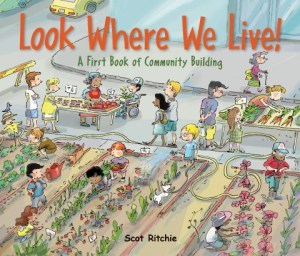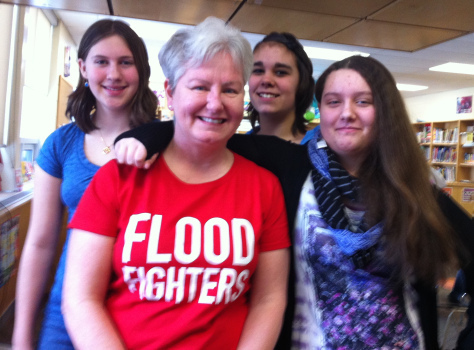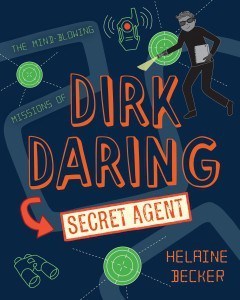Penny Draper's Blog
June 11, 2015
Look Where We Live!
By Scot Ritchie, Published by Kids Can Press
ISBN 13: 978-1-77138-102-4
Nick, Yulee, Pedro, Sally and Martin are ready for an adventure! Their community is going to have a street fair to raise money for the library, and they all want to help out. Starting at Nick’s house, the five friends explore their neighbourhood, learning about the people and places that make up their community.
Look Where We Live! is Scot Ritchie’s third offering in his series of ‘first books’, stories that encourage young readers to explore their sense of place. Fun, colourful, and informative, it successfully simplifies the complex concept of community for the youngest readers, inviting them to be part of a larger whole in a clear and welcoming way.
Starting with a map of the neighbourhood, the children visit places like the school, the soccer field, the police station and the retirement home, learning how each place – and the people within it – contribute to the community. Concepts are presented on both a micro and macro level: Nick learns that by selling his old toys at a garage sale he can make $4 for the library, a small act that introduces the larger idea of donation. And the ‘Where’s Waldo’format is full of humorous detail (like naughty Max, the dog!) that will delight the eagle-eyed reader.
The book includes a table of contents, a glossary, an art activity and a number of open-ended questions aimed at helping kids understand their own communities. Ritchie has a knack for making big ideas accessible, making this an excellent book for home or school.
Reviewed by Penny Draper for the National Reading Campaign
 The National Reading Campaign publishes children’s book reviews under a Creative Commons License. This review is entirely free to reproduce and republish online and in print. Credit must be given to the reviewer and the National Reading Campaign. Reviews can be edited for brevity only. Contact Us for more information.
The National Reading Campaign publishes children’s book reviews under a Creative Commons License. This review is entirely free to reproduce and republish online and in print. Credit must be given to the reviewer and the National Reading Campaign. Reviews can be edited for brevity only. Contact Us for more information.
Filed under: Book Reviews

February 3, 2015
Shout out to Huntsville Public School!
Thanks to Principal Ross Jewiss and all the students at Huntsville Public School for a wonderful visit today. Your questions still have me thinking, and I have to say (being a Westcoaster) that I really enjoyed the snow!
Filed under: Writing

December 9, 2014
Our Heroes: How Kids are Making a Difference
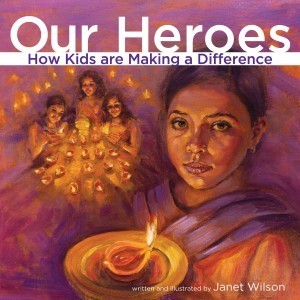
By Janet Wilson
“How can one of us be happy if all the other ones are sad?” (Xhosa child)
Our Heroes begins with the story of ubuntu, an African word that loosely translated means humanity. Ubuntu recognizes that all people are connected, that we are part of a greater whole. It is a small word for a big idea and in Janet Wilson’s Our Heroes, it is small people who put it into action.
In Wilson’s third book in her series about children who make a difference, she has collected stories of young activists from around the world. Each child decided to take action after a personal experience illuminated for them one of the world’s terrible injustices. They take on hunger, poverty, discrimination and violence with heartfelt, well-focused ideas. Arti works towards eliminating prejudice in her temple so that her low-caste friend can worship too. Kesz provides flip-flops to protect the feet of the children who must scavenge the dump to live. Adib shows farmers how to use mobile technology to get a fair price for their crops. Their stories will inspire, as will the young activists’ words of advice. Find something you’re passionate about. Share. You’re never too young. Don’t let your parents stop you!
Her portraits of the children are warm and engaging, and the photo layout is informative. The book will inspire children and humble adults, and is a must-have for schools, libraries and families interested in social consciousness.
Our Heroes: How Kids are Making a Difference
Written and illustrated by Janet Wilson
978-1-927583-41-8
Second Story Press
September 12, 2014
32 pp
Ages 6-12
Reviewed by Penny Draper for the National Reading Campaign
 The National Reading Campaign publishes children’s book reviews under a Creative Commons License. This review is entirely free to reproduce and republish online and in print. Credit must be given to the reviewer and the National Reading Campaign. Reviews can be edited for brevity only. Contact Us for more information.
The National Reading Campaign publishes children’s book reviews under a Creative Commons License. This review is entirely free to reproduce and republish online and in print. Credit must be given to the reviewer and the National Reading Campaign. Reviews can be edited for brevity only. Contact Us for more information.
Filed under: Book Reviews Tagged: activism, book review, heroes, Janet Wilson, philanthropy, picture book, young activists

December 6, 2014
The Tale of the Black Pig
 A black pig, a government edict, an old oak tree and an open window…throw in a pile of salt and untold riches and what have you got? A good story, at the very least.
A black pig, a government edict, an old oak tree and an open window…throw in a pile of salt and untold riches and what have you got? A good story, at the very least.
While walking up La Rambla in Barcelona, I almost stumbled as my feet stepped into a field of raw meat. Stretching across the sidewalk, a path of marbled pink led me up an escalator (also made of meat) and into a wine bar. The elegant host handed me a menu. My Spanish is poor, but as far as I could tell I was being offered a wine and boar tasting. I enjoy a good prosciutto, I thought to myself, and I’m always up for a glass of wine. Luckily I did not express this blasphemy aloud, as I would not only have been expelled from the restaurant, but perhaps from Spain as well.
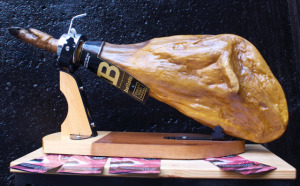 I was actually being offered the opportunity to taste Jamón Ibérico de Bellota, or acorn-fed black pig, one of the world’s gastronomic treasures. Paper-thin slices of pork were being served on plates warmed to exactly 27° C (80° F), just the right temperature for the rivers of marbled fat to begin to melt, a fat so sweet it is sometimes used to wrap cherries for dessert. Paired with a crisp manzanilla or a dry fino sherry and it wasn’t just the fat melting; I was too. The sweet, nutty delicacy was a heavenly shock after the somewhat tawdry, albeit effective, meat escalator. What was this stuff?
I was actually being offered the opportunity to taste Jamón Ibérico de Bellota, or acorn-fed black pig, one of the world’s gastronomic treasures. Paper-thin slices of pork were being served on plates warmed to exactly 27° C (80° F), just the right temperature for the rivers of marbled fat to begin to melt, a fat so sweet it is sometimes used to wrap cherries for dessert. Paired with a crisp manzanilla or a dry fino sherry and it wasn’t just the fat melting; I was too. The sweet, nutty delicacy was a heavenly shock after the somewhat tawdry, albeit effective, meat escalator. What was this stuff?
The uninitiated will call it ham, but for the Spanish this meat stands in a class of its own. An epicure could write pages on the complexity of jamón, a food so exquisite it is sometimes wrapped in gold leaf, but I am not an epicure. I am a storyteller and the Tale of the Black Pig is an interesting one.
Long ago, when men first began to domesticate animals, the Phoenicians brought pigs to Spain from Lebanon. They interbred with wild boars and produced a new breed: large, long-legged, fine boned, with black tails and hooves. Left to roam in the ancient oak forests of the Iberian Peninsula, they feasted on magic acorns during the dark days of winter, becoming bigger and fatter than any pigs that came before. And the acorns really were magic. Inside the pig’s body they triggered a sophisticated chemical reaction that transformed half the pig’s fat from artery-clogging saturated fat to monounsaturated oleic acid full of antioxidants. It’s good fat. I’m debating about adding acorns to my diet.
After the matanza, or traditional slaughter, the hams were kept in hills of salt for nine days, then washed and hung to dry in the mountain air for up to three years, losing half their size. The abundance of this wonderful fat allowed for the long curing time, which in turn produced the complex, intense flavour of the meat. It’s said that the only mechanical intrusion into this traditional process was a button that opened and closed the windows of the curing sheds to allow the mountain air to do its work. The result: the aforementioned untold riches and a happily-ever-after for the story.
And although that’s the end of the pig, it’s not the end of the tale. There’s a prequel. 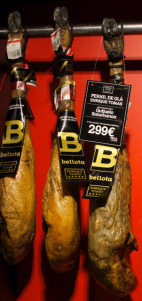 Traditional practices such as the one that produces Jamón Ibérico de Bellota are honed by history and steeped in lore. Before the Middle Ages, bellota ham was just for peasants. The oak forests were there, the black pigs were there; bellota ham was the available food source. (Editorial note: lucky, lucky peasants!) That was before the Spanish Inquisition, when luck ran out for many.
Traditional practices such as the one that produces Jamón Ibérico de Bellota are honed by history and steeped in lore. Before the Middle Ages, bellota ham was just for peasants. The oak forests were there, the black pigs were there; bellota ham was the available food source. (Editorial note: lucky, lucky peasants!) That was before the Spanish Inquisition, when luck ran out for many.
Land ownership in the Iberian Peninsula changed dramatically as farms were consolidated under Church and military control. But the land was poor, the climate unpredictable and dry. Leaders worried that collective farming would ruin the land, so decreed that farmers had to adopt a multi-use approach. The rangeland management system that was developed required retention of the oak forest (with some thinning allowed), along with some agriculture, some grassland and some grazing. This system created a sustainable agroforestry ecosystem that remains in place today, called a dehesa. The oak trees provide renewable cork, as well as wild mushrooms, charcoal, tannin and firewood. The acorns feed the black pigs. The grasslands provide barley, oats and rye for goats, sheep, cattle and horses. These grazers keep down the shrub growth and provide milk. The dehesa also supports wild game, which is hunted for meat.
So today, despite poor land, the dehesas are not only economically successful but contain some of the highest biodiversity in the world. Home to endangered species such as the Iberian Lynx, Iberian Eagle, Black Vulture and Black Stork, they also sequester 3-5 times more CO2 than other forests during periods of bark regeneration after cork harvesting. The popularity of Jamón Ibérico de Bellota is helping local farmers maintain the ecosystem and retain rural jobs rather than submit to pressure to develop the real estate. From a tragic period in history comes a positive outcome.
And it was melting on my plate. With every succulent bite I taste the past and the future. It’s definitely a happily-ever-story, just not for the poor Black Pig.
Filed under: Travel, Writing Tagged: acorn, Arizona, Barcelona, Black Pig, Black Stork, Black Vulture, cork, dehesa, ham, Iberian eagle, Iberian lynx, Jamón, Jamón Ibérico de Bellota, Spain, Spanish Inquisition, travel writing, wild boar

November 25, 2014
Finding the Story: Barcelona
 Casa Batlló, Barcelona
Casa Batlló, BarcelonaVisiting Barcelona for just three days is not enough. Three days offers no more than a few ticks on the travel checklist, should one actually have such a thing:
√ Check out Gaudí
√ Eat tapas
√ Stroll Barceloneta Beach
Then move on. It’s frustrating and exhausting and exhilarating. In three days you can’t be a traveler, you can only be a tourist and who wants to be lumped in with that crowd? I’m told by others that I should be grateful even to have three days and I am, really, but I can’t help the desperation that rises within to see it all, hear it all, feel it all. My head swivels and my eyes bug out until the thousands of impressions make my brain soggy. Being a tourist reduces me to a caricature of my former self.
At the end of the three days I close my eyes and let all those impressions swirl like the coloured wax in a lava lamp. (Some call it exhaustion but I prefer to think of it as a creatively restful state.) Slow, heavy, breaking apart, realigning, changing colour: images of jamón ibérico roil with Catalan wine as trencadís salamanders sparkle. I repeat – this is not exhaustion. Or anything stronger. It’s an indulgence of the senses.
But it doesn’t mean anything.
This line was famously said by one of the von Trapp children in The Sound of Music, with reference to music notes. And it’s true; taken individually, all my impressions are as meaningless as a single note. I could just list them, or put them in a slideshow to bore my relatives, but that doesn’t give me a story. I need to find the music of the memory.
 I want my story to be about architect Antoni Gaudí, with his crazy chimneys, bassoon-playing angel and unfinished masterwork, La Sagrada Familia. But thanks to a malfunctioning sensor, my memory of him has become the story of his death. This one impression obliterates all the rest, no matter how hard I try to bury it. It’s like a terrible song that I can’t get out of my head.
I want my story to be about architect Antoni Gaudí, with his crazy chimneys, bassoon-playing angel and unfinished masterwork, La Sagrada Familia. But thanks to a malfunctioning sensor, my memory of him has become the story of his death. This one impression obliterates all the rest, no matter how hard I try to bury it. It’s like a terrible song that I can’t get out of my head.
Here’s how this came to be. When you only have three days you have to take advantage of time-saving tourist aids. In my case, that was the hop-on, hop-off bus.  Barcelona has cleverly installed personal audio systems at every seat, and the audio is apparently triggered by sensors on the roadway. One block before a famous sight, the system tells you all about what you’re going to see. Get stuck in traffic and the audio waits patiently with you. It’s a great system except when it malfunctions. Up near the stop for Parc Güell, the audio sombrely announced that
Barcelona has cleverly installed personal audio systems at every seat, and the audio is apparently triggered by sensors on the roadway. One block before a famous sight, the system tells you all about what you’re going to see. Get stuck in traffic and the audio waits patiently with you. It’s a great system except when it malfunctions. Up near the stop for Parc Güell, the audio sombrely announced that  at the upcoming intersection Gaudí met his death. He was run over by a trolley, which is a sad fate indeed. Two blocks later Gaudí again met his death by trolley. Four intersections further along, he died again. The malfunction would have been funny had it not been for the fact that we were talking about a man’s death. Please, please, I thought, don’t let it happen again!
at the upcoming intersection Gaudí met his death. He was run over by a trolley, which is a sad fate indeed. Two blocks later Gaudí again met his death by trolley. Four intersections further along, he died again. The malfunction would have been funny had it not been for the fact that we were talking about a man’s death. Please, please, I thought, don’t let it happen again!
So now, all my memories of Barcelona keep getting run over by a trolley. I want to remember the sheer genius of Gaudí’s work but then BAM! There’s that darn trolley again. And I remember that a great man died and I think of his legacy and I look around at the art and architecture that are the crown jewels of this city, done by the many artists that tried something new because Gaudí showed them how and…I had my story.
That malfunctioning sensor sang a terrible song, but it provided the music for my memory. It will forever remind me of the man who gave this city its heart. Whether it’s the food, the beach, the buildings or the people, it’s a city that knows how to colour outside the lines. And that’s because Antoni Gaudí once lived there, before he was run over by a trolley.
Filed under: Travel, Writing Tagged: architecture, Barcelona, finding the story, Gaudi, Sagrada Familia, Spain tourism, travel writing

November 18, 2014
Dreaming in Indian
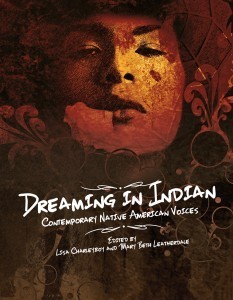
Edited by Lisa Charleyboy and Mary Beth Leatherdale
“There is a lot of pressure on youth right now, everyone is telling you what you should be doing. Telling your own stories is empowering because self-expression is freedom – a way to find your own voice.”
-Danis Goulet (Cree/Métis) Filmmaker
Dreaming in Indian: Contemporary Native American Voices is about voice. A compilation of personal stories from indigenous youth, the collection includes writers, artists, dancers, filmmakers, photographers and creative thinkers who are trying to make sense of their lives. Their experiences will resonate with both Native and Non-Native readers, because the act of hearing the struggles of one person gives insight into the struggles of all.
Editors, Lisa Charleyboy and Mary Beth Leatherdale, bring strong literary and cultural credentials to the work. They have selected and organized the entries well, resulting in a cohesive and flowing narrative. The book is divided into four sections: Roots, Battles, Medicines and Dreamcatchers. In Roots one senses strength, but in the dark pages of the Battles section the stories become angrier. The swirling picture collages of designer Inti Amaterasu are atmospheric, suggesting the alienation Native youth feel. But the book ends with hopes that are nothing less than heroic. The stories shared by Aboriginal superstars such as Olympic athlete Waneek Horn-Miller, acclaimed author Joseph Boyden and business entrepreneur Louie Gong are illuminating and inspiring.
Beautifully produced, this is a powerful book. Each reader will hear a different voice; one hopes that close listening will result in a choir of voices, each unique but singing a complementary melody.
Dreaming in Indian: Contemporary Native American Voices
Edited by Lisa Charleyboy and Mary Beth Leatherdale
978-1-55451-687-2
Annick Press
July 24, 2014
128 pp
Ages 12+
 Reviewed by:
Reviewed by:
Penny Draper lives in Victoria, British Columbia. She is the author of the award-winning “Disaster Strikes!” series, historical fiction that places young protagonists at the centre of real Canadian disasters.

The National Reading Campaign publishes children’s book reviews under a Creative Commons License. This review is entirely free to reproduce and republish online and in print. Credit must be given to the reviewer and the National Reading Campaign. Reviews can be edited for brevity only. Contact Us for more information.
Filed under: Book Reviews Tagged: book review, Charleyboy, Dreaming in Indian, First Nations literature, Leatherdale, National Reading Campaign, Native American, YA

November 11, 2014
From Vimy to Victory
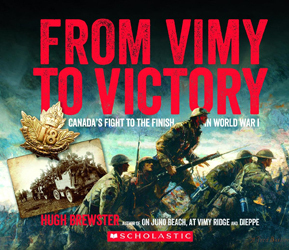
By Hugh Brewster
Published by Scholastic Canada
ISBN 13: 978-1-4431-2461-4
As seen in his previous award-winning books At Vimy Ridge and Dieppe, Hugh Brewster, is known for his ability to capture the essence of important turning points in Canadian history for young people. In From Vimy to Victory, Brewster has once again crafted a magnificent gift for Canadians of all ages. By piecing together photographs, maps, personal accounts, paintings and quotations, Brewster has woven together the story of the end of WWI with great clarity, poignancy and inspiration returning it back to a new generation lest they forget.
It begins with a ghost. Will Bird’s near escape from death in a bivouac immediately draws readers into the mayhem, terror and frustration of the trenches. Readers can feel the mud in their boots as Will’s regiment fights their way from Vimy to Hill 70, then to Ypres (called Wipers because it “was a likely place to get wiped out”) and finally Passchendaele. Strategy is considered from the point of view of Lt-General Arthur Currie, the first Canadian to command the 100,000 men of the Canadian Corps. Adding to the realism is the changing dynamic of the front line, clearly illustrated in colourful maps, and archival photographs. Sidebars celebrate the heroism of ordinary men and women as the story marches towards the eleventh hour of the eleventh day.
It is said that WWI was the war that made Canada into a country. In this cohesive and moving retelling of events, Brewster tells us how the incredible accomplishments of the Canadian Corps made it possible.

The National Reading Campaign publishes children’s book reviews under a Creative Commons License. This review is entirely free to reproduce and republish online and in print. Credit must be given to the reviewer and the National Reading Campaign. Reviews can be edited for brevity only. Contact Us for more information.
Filed under: Book Reviews Tagged: book review, children's book reviews, Hugh Brewster, National Reading Campaign, picture book, Vimy, war, World War I, WW1

November 10, 2014
Dance of the Banished
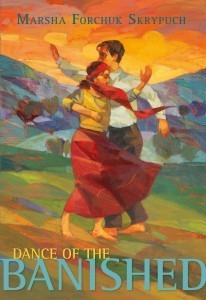 By Marsha Skrypuch
By Marsha Skrypuch
In Dance of the Banished, acclaimed author, Marsha Skrypuch, once again breathes life into a piece of history with passionate clarity. Published on the one hundredth anniversary of World War I, Dance of the Banished tells the dual stories of alien internment in Canada and the Armenian Genocide in Turkey, both from an unusual perspective.
Zeynap, fierce and bold, and Ali, caring and principled, live in the same village in Anatolia and plan to marry. Unexpectedly, Ali is sent to Canada and Zeynap is left behind. Each writes in a journal for the other, but as war comes to both countries it is unlikely their words will ever be shared. Still, they keep on. Zeynap writes an eyewitness account of the genocide from the point of view of the Alevi Kurds, telling a little known side of this tragic story. Ali, in turn, gives an accounting of life in an internment camp in, surprisingly, Kapuskasing. For each, the journal entries are a coping mechanism, a way to bear witness to the atrocities of war and ultimately, to bring justice.
Skrypuch’s compelling characters give an authentic voice to this well researched story. It is definitely a book for adults as well as teens. And although it is a story of war it includes moments of great joy, making it much more than a tragedy. Whether together in Turkey or alone in banishment, both Zeynap and Ali are able to lose themselves when they dance. Their troubles are momentarily forgotten in an ecstasy of whirling that reminds us of the cyclical nature of human events. Preserving the past, as Skrypuch does so well, is part of that cycle.
Dance of the Banished
By Marsha Skrypuch
978-1-927485-65-1
Pajama Press
August 22, 2014
288 pp
Ages 12+
Filed under: Book Reviews Tagged: Armenian, book review, children's book reviews, Marsha Skrypuch, Marsha Skrypuch In Dance, the Banished, Turkey, war, YA

October 22, 2014
Dirk Daring, Secret Agent
Darren Dirkowitz, a.k.a. Secret Agent Dirk Daring, has the stealth and cunning of the panther, the patience of the chameleon, the stillness of the serpent, and the strength of the spider. Dirk Daring is a master spy. But sometimes even master spies need help navigating Grade Five.
Helaine Becker has created a delightful hero in underdog, Darren Dirkowitz. Labeled a geek, Darren is practically a social outcast. Plagued with an evil stepbrother and infatuated with the prettiest girl in the class, there are just so many ways for him to have a bad day. When his secret spy journal is stolen and Darren is threatened with exposure, school-wide humiliation seems inevitable—were it not for the special skills of Dirk Daring.
Chock full of code names and encrypted missions, comic doodles and handwritten editorial comments, Dirk Daring, Secret Agent is a high-energy race car speeding to what looks like certain disaster. But underneath is a gentle and thoughtful look at the scary parts of being ten years old: Who will be my friend? Will people make fun of me? Will the bullies get me?
This is a highly imaginative and enjoyable read and the underlying message adds to, rather than detracts from the fun. Spoiler alert – the bad guys are punished in the end. But just who ARE the bad guys? Only Dirk Daring knows for sure.
Dirk Daring, Secret Agent
By Helaine Becker
978-1-4598-0683-2
Orca Book Publishers
October 1, 2014
208 pp
Ages 8-11


September 3, 2014
Back to School – Not
Right across the country, kids went back to school yesterday, except in British Columbia. Here, a half million students are getting an extra long summer holiday while their teachers are on strike. As in all disputes, there are myriad issues: class size, class composition, pay rates, benefits and a Supreme court ruling to name a few. I’m not an educator or a negotiator or a member of government so I take no sides. Except perhaps to say that we should probably be listening to the people who are actually teaching our children about whether or not we need another bandage on our post-war system, or whether it’s time to rip the bandage off and start again. No, I’m a writer, and I’ve noticed something unusual in our community these last two days.
There are kids on bikes all over the place. Well, obviously, the kids have to be somewhere. But why didn’t I see them all summer? There was no school then either. There are middle school kids at the bus stop, alone. I don’t usually see that either. The park was packed. (It was barely used all summer.) Mobs of moms chatted with one another, smiling, while a ten-year-old hopped on his pogo stick and a line of kids waited patiently for the slide. A dad played tennis with two tweens on the free court. I can’t help myself when I people-watch; I just have to make up stories about all the people I see. I’ll bet that dad was a lawyer or a businessman, because his shorts didn’t sit easily, as if they hadn’t been used much. He had a lousy serve but was grinning like crazy. Everyone I saw today was happy.
In no way do I want to minimize the terrible hardship and stress this strike is placing on families. It’s a disaster. But, we must remember that disasters have the potential to bring out the best in people. They are a time-out-of-time, with different rules, changed schedules and forced flexibility. They give us the opportunity to try new things. In a disaster, we can only concentrate on the things that are most important, letting all else fall away. I’m almost always surprised that what I thought was most important never is.
The kids will go back to school eventually. Our job is to remember the good, if any, that comes out of the changes we have been forced to make. It could be increased independence, more unscheduled time to play, less time at work or learning how to accept help from friends and neighbours without feeling guilty.
We rarely take a time-out-of-time, as they seem a luxury beyond imagining. Most often they are forced upon us, and it’s hard to see them as a gift. But we need to try, or the potential to learn something different – something precious – will be forever lost.



